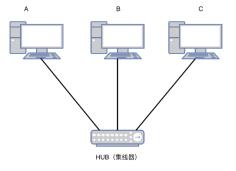What is a LAN?
LAN means Local Area Network.
A LAN represents a broadcast domain, which means that all members of the LAN will receive broadcast packets sent by any member. Members of the LAN can talk to each other and can set up their own ways for computers from different users to talk to each other without going through the Internet.
1) The most basic LAN layout
As shown in the figure above, it is the most basic LAN layout. If there are different devices, you need to obtain the other’s MCA address.
Detailed example: A sends information to C, but A does not know the MAC address of C. At this time, through the ARP protocol (Address Resolution Protocol;) To obtain the MAC address of C, A first broadcasts an ARP request containing the target IP address to all devices linked to the hub. After receiving the broadcast, C returns the MAC address to A, and other devices discard the information. So far, the preparation conditions for communication between devices have been established. The above process can be simplified as follows: A — ARP protocol: resolves the MAC address of the target IP — C will return the MAC address to
The devices linked in the hub are in the same conflict domain and broadcast domain. Because there is only one switch, the conflict domain is the broadcast domain. The simple understanding of this layout is that only one device can send a signal at a time and other devices can receive the signal.
2) The hub is the physical layer device, that is, the first layer of OSI. It is mainly used to receive, restore, amplify, and send signals. When twisted pair and optical fiber are used to transmit signals, with the increase in distance, the signals will weaken and cause distortion. The signal distortion will cause the transmission data to be unrecognized, and eventually cause signal interruption. With the help of the hub, the signal can travel farther; At the same time, the hub has many interfaces, which can expand the number of terminals and the size of the LAN.
The Problem: All devices on the same hub share bandwidth. If the number of devices is too large, it will cause link congestion and, in serious cases, a broadcast storm.
Progress: A large conflict domain can be divided into multiple small conflict domains by using the switch, which can reduce the scope of the conflict domain and reduce data congestion.
The above is the knowledge explanation of ONU LAN brought to you by Shenzhen HDV Phoelectron Technology Co., Ltd. Shenzhen Haidiwei Optoelectronics Technology Co., Ltd. is a manufacturer specializing in optical communication equipments.






